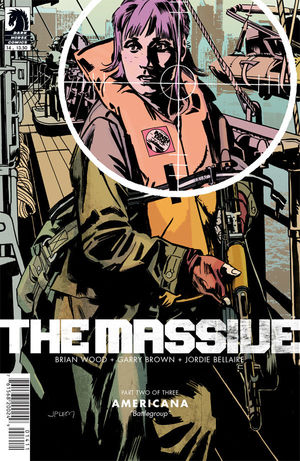- Comics
- Comics Reviews
- Manga
- Comics Reviews
- European Comics
- News
- Comics News
- Press Releases
- Columns
- Spotlight
- Digital Comics
- Webcomics
- Cult Favorite
- Back Issues
- Webcomics
- Movies
- Toys
- Store
- More
- About
By Zak Edwards
July 26, 2013 - 21:07
Brian Wood’s return to New York in The Massive is significant, not only in terms of plot and the story, but also in terms of thematics relating to his previous work. It’s no secret that DMZ, Wood’s love letter to the city, is strongly tied to this series and the shift happening aboard the Kapital is certainly indicative of the past coming back to haunt the present. Sure, Matty Roth isn’t making a cameo anytime soon, but DMZ’s New York is, in many ways, still present in Wood’s story here, albeit underwater and less densely populated.
The Massive has been coming to a head in waves now, with every issue resolving tensions by displacing onto others while ensuring the focus is on Callum Israel’s increasingly fractured crew. With Israel’s discovery of the titular ship a few issues ago, changes aboard the Kapital have alienated much of his crew, including the increasingly mutinous Mag and Ryan, who are two sides of a very similar coin. But this issue is all about the past, it’s relationship to the present, and how it looms into the future, from the boiling over relationships between crew members to the threats by various rogue military groups. Like DMZ, the fractal nature of America is a base assumption, exposing how the divisions are a double-edged sword. The United States Government isn’t really in charge, and Israel’s knowledge of this plays out the cliffhanger from last issue well, increasing tension by dissipating to a less definable threat. And this tension sustains the issue, with the Kapital’s recent encounter with Moksha, the faux-utopia that recently lost the nuclear submarine lying in wait in New York, looms below, but Wood’s main characters aboard the Kapital steal the show. The ship is as fractured as their enemies, with looming conflicts, particularly Mag and Ryan, whose general animosity only makes more sense as their loyalties become increasingly complicated. So while Ryan’s defection feels like a release of tension, some sort of resolution, her return and subsequent actions only add more mystery, this deflection of tension that makes things feel like they are coalescing and falling apart all at once, which just makes a damn good read, particularly on a month to month basis!

Garry Brown’s art continues to shine, and Jordie Bellaire’s colours are only helping. The differentiation of time, which plays into the issue’s concerns over the past and future, the drawing of history into a formulation of moving forward. The heavy palettes to differentiate between periods is an immediate visual clue, but Brown’s style works across these massive shifts exceptionally well, partly because of his light approach, but also because of his stark panelling choices. Most pages in the present use a larger picture as a backdrop, with panels laid on top, unifying the page into a sort of singular moment that is simply great to look at. But the flashbacks use heavy blacks and whites, throwing the background effect away to create stronger individual moments over a bleeding of time. The effect, like I said, looks great and keeps the pages focused on what matters: the setting, an especially important aspect to consider in a book about environmental collapse.
Grade: 8.5/10 Still one of the best books on the shelves, decidedly unique in a genre filled with exhaustion.